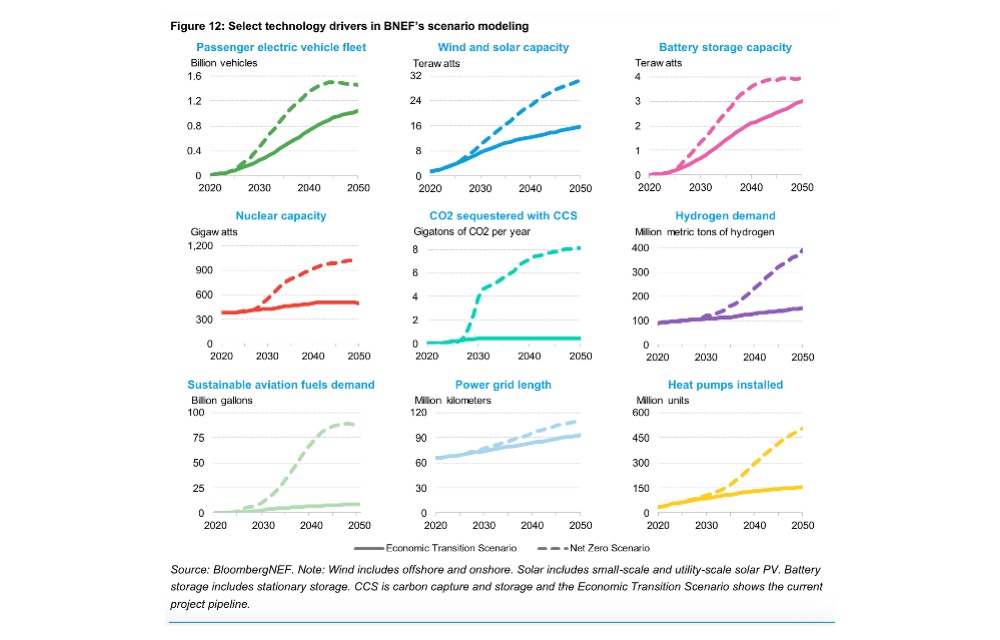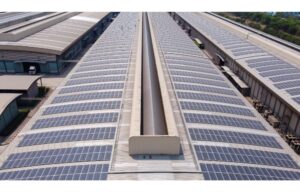- BNEF’s new report calls for urgent deployment of clean energy technologies to get closer to the 2050 net-zero goal
- Renewable energy technologies of wind and solar need to triple from today to 31 TW by 2030, and triple further thereon till 2050
- The world will need to watch out for land constraints that may slow down the speed of renewable energy deployment
The New Energy Outlook 2024 report of the Bloomberg New Energy Finance (BNEF) names 9 keystone technologies that it says will make or break the net-zero transition and whose deployment can help stall emissions. Since the world has little time left to achieve the 2050 net-zero goal, it calls for urgent deployment of existing technologies, including wind and solar, to get closer to the target.
NZS
Under the report’s Net-Zero Scenario (NZS), wind and solar capacity should reach 31 TW by 2030, tripling from today, and tripling again between 2030 and 2050.
These renewable energy technologies, along with electric vehicles (EV), energy storage and power grids, are among 4 mature and commercially scalable technologies in the list of 9. Installed battery storage capacity will scale up by more than 50 times 2023 levels to 4 TW by 2050 under the NZS. Power grids will grow to 111 million kms in length, almost double from today.
While these still need to expand significantly, according to the report writers these carry little to no technology risk, their economic premiums are small or non-existent and financing models are already at scale.
The remaining 5 technologies on the BNEF list are nuclear power, carbon capture and storage, clean hydrogen, sustainable aviation fuel consumption and heat pumps.
ETS
Under the report’s Economic Transition Scenario (ETS), clean energy technologies are only deployed where they are economically cost-competitive or adopted by consumer choice. These then do not require any further policy support.
According to the report, “The affordability of renewable energy, especially solar and wind, means that they grow rapidly in this scenario, to 51% of global power generation by 2030, and 70% by 2050. The global power system is transformed and becomes much more flexible in order to accommodate high penetrations of wind and solar.”
Calling renewable energy, EVs and energy storage ‘no-regrets choices,’ BNEF’s Head of Energy Economics Matthias Kimmel believes these 3 technologies can help countries reduce emissions, improve energy security and even reduce energy system costs today.
Investment
In terms of investment, BNEF counts 19% more investment in NZS at $215 trillion compared to $181 trillion for ETS. While the small difference is due to EVs expected to achieve cost-competitiveness, it is the capital-intensive clean energy technologies that are likely to incur $79 trillion investment. BNEF adds that it excludes operating expenditure from this analysis which would likely be higher for fossil-fuel technologies.
It argues that “Getting on track for the NZS requires a significant step up for clean energy supply and a gradual scaling down for fossil fuels. For every dollar invested in fossil-fuel supply, $4.5 must go to low-carbon energy supply by 2030.
Geographical concerns
In terms of geographical spread, BNEF finds the Nationally Determined Contributions (NDC) of Brazil, France, the UK, the US and Australia as the most aligned to its NZS. On the other hand, the NDCs of Germany, South Korea, Japan and India have existing NDCs that are in line with or better than the ETS, which means they have scope to raise their ambition to align with the NZS.
Both onshore wind and solar projects are expected to require 2.9 million sq. km. of land by 2050 under the NZS scenario, almost 15 times more than these were using in 2023.
Land constraints in any region will bring a saturation in the construction of wind and solar projects. It will be most keenly felt by land-constrained nations like South Korea, Vietnam and Japan. These nations will then drift towards less land-intensive technologies.
However, the report points out that under the ETS there is no risk of saturation in their development, meaning there is still scope for growth for renewables across all geographies. It recommends dual-use of land for solar or wind along with food as one way to resolve this conflict.
It adds, “The way in which these segments compete for, and co-exist on, the same land will shape future permitting and zoning rules, particularly if the rollout of low-carbon technologies is seen to threaten food security.”
Nevertheless, the report writers add that irrespective of whether the world heads towards net zero or not, fossil fuels’ dominance is coming to an end. Even without any further policy drivers, renewables could still exceed 50% share of electricity generation by 2030.
The complete report is available to BNEF’s clients, while an executive summary is available on its website.



